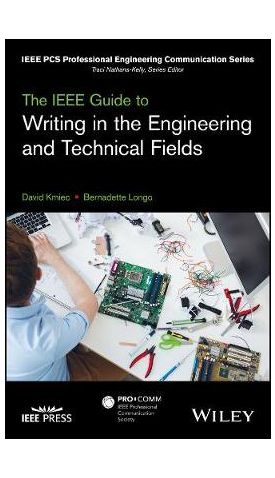אנו משתמשים ב-Cookies כדי לשפר את החוויה שלך. כדי לקיים ההנחיה החדשה של e-Privacy, עלינו לבקש את הסכמתך להגדיר את ה-Cookies. קבלת מידע נוסף.
437.00 ₪
The IEEE Guide to Writing in the Engineering and Technical Fields
437.00 ₪
ISBN13
9781119070139
יצא לאור ב
Hoboken
זמן אספקה
21 ימי עסקים
עמודים
200
פורמט
Paperback / softback
תאריך יציאה לאור
10 בנוב׳ 2017
שם סדרה
IEEE PCS Professional Engineering Communication Series
Helps both engineers and students improve their writing skills by learning to analyze target audience, tone, and purpose in order to effectively write technical documents
This book introduces students and practicing engineers to all the components of writing in the workplace. It teaches readers how considerations of audience and purpose govern the structure of their documents within particular work settings. The IEEE Guide to Writing in the Engineering and Technical Fields is broken up into two sections: "Writing in Engineering Organizations" and "What Can You Do With Writing?" The first section helps readers approach their writing in a logical and persuasive way as well as analyze their purpose for writing. The second section demonstrates how to distinguish rhetorical situations and the generic forms to inform, train, persuade, and collaborate.
The emergence of the global workplace has brought with it an increasingly important role for effective technical communication. Engineers more often need to work in cross-functional teams with people in different disciplines, in different countries, and in different parts of the world. Engineers must know how to communicate in a rapidly evolving global environment, as both practitioners of global English and developers of technical documents. Effective communication is critical in these settings.
The IEEE Guide to Writing in the Engineering and Technical Fields
Addresses the increasing demand for technical writing courses geared toward engineers
Allows readers to perfect their writing skills in order to present knowledge and ideas to clients, government, and general public
Covers topics most important to the working engineer, and includes sample documents
Includes a companion website that offers engineering documents based on real projects
The IEEE Guide to Engineering Communication is a handbook developed specifically for engineers and engineering students. Using an argumentation framework, the handbook presents information about forms of engineering communication in a clear and accessible format. This book introduces both forms that are characteristic of the engineering workplace and principles of logic and rhetoric that underlie these forms. As a result, students and practicing engineers can improve their writing in any situation they encounter, because they can use these principles to analyze audience, purpose, tone, and form.
| עמודים | 200 |
|---|---|
| פורמט | Paperback / softback |
| ISBN10 | 1119070139 |
| יצא לאור ב | Hoboken |
| תאריך יציאה לאור | 10 בנוב׳ 2017 |
| תוכן עניינים | A Note from the Series Editor, ix About the Authors, xi PART I A TECHNIQUE FOR WRITING LIKE A PROFESSIONAL 1 Introduction, 3 1 The Social Situation of Text 7 The Social Contexts for Technical Writing, 8 Models of the Writing Environment, 9 Transmission Models, 10 Correctness Models, 11 Cognitive/Behavioral Models, 13 Social/Rhetorical Models, 14 This Guide's Approach, 16 The Rhetorical Situation: Purpose, 18 The Rhetorical Situation: Audience, 21 The Rhetorical Situation: Identity, 26 The Rhetorical Situation: Context, 28 The Pragmatic Situation: Community and Genre, 29 2 Making Writing Decisions 33 Introduction, 34 Document Structure and Granularity, 35 Arranging Text at the Macro Level, 37 Sectioning and Heading Sections, 39 Aids for Navigating and Understanding Document Structure, 43 Creating Effects with Lexis and Syntax at the Micro Level, 45 Lexical Technique: Word Choice, Technical Terms, and Hedges and Boosters, 47 Syntactic Technique: Modification, Clausal Arrangement, and Discursive Cueing, 53 Intermediate Structural Units and Argumentative Movement, 68 Paragraph Cohesion and Paragraphs as Structural Units of a Document, 69 Structures Other than Paragraphs, 72 Citations and Other Intertextual Statements, 73 Implications for the Process of Writing, 75 Additional Reading, 77 PART 2 WRITING DOCUMENTS 79 Introduction 81 3 Writing to Know: Informative Documents 85 Introduction, 86 The Purposes of Informative Documents, 86 Occasions for Preparing an Informative Document, 88 Audiences for an Informative Document, 88 Key Communication Strategies When Writing to Know, 90 Understanding What Constitutes Sufficient Evidence to Support a Claim, 90 Structuring Evidence in Your Document, 91 Establishing Expertise, 92 Questions for Analyzing Existing Documents, 93 Some Typical Informative Documents, 93 Reports, 93 Specifications, 104 4 Writing to Enable: Instructions and Guidance 109 Introduction, 110 The Purposes of Enabling Documents, 110 Occasions for Preparing an Enabling Document, 112 Audiences for an Enabling Document, 112 Key Communication Strategies When Writing to Enable, 113 Anticipating a Document's Use Context, 113 Deciding How Much Background Is Warranted, 115 Testing the Document with Users, 116 Questions for Analyzing Existing Documents, 119 Characteristic Enabling Documents, 119 Manuals/Guides and Other Documents That Primarily Contain Instructions/Directions/Procedures, 119 Tutorials/Training Materials, 128 Policies, 130 5 Writing to Convince: Persuasive Documents 133 Introduction, 134 The Purposes of Persuasive Documents, 134 Occasions for Preparing a Persuasive Document, 135 Audiences for the Persuasive Document, 136 Key Communication Strategies When Writing to Convince, 137 Designing Your Argument to Consider the Audience's Preexisting Beliefs, 137 Using the Terms and Values of the Audience to Articulate a Shared Goal, 140 Assuring Outcomes and Benefits without Seeming Unrealistic, 142 Questions for Analyzing Existing Documents, 143 Typical Examples of Persuasive Documents, 145 Proposals, 145 Business Plans, 149 6 Correspondence: Medium of Workplace Collaboration 155 Introduction, 156 The Purposes of Correspondence, 157 Occasions for Preparing Correspondence, 158 Audiences for Correspondence, 158 Key Communication Strategies When Corresponding, 160 Consider Workplace Roles and Official and Unofficial Relationships and Responsibilities, 160 Evaluate Target Size and Frequency of Communication for a Relationship, 162 Pause to Reconsider Composition, Time, and Tone before Sending, 163 Characteristics of Correspondence Documents, 165 Letters, Memoranda, and E-mails, 165 Types of Correspondence, 167 Pre- and Post-meeting Documents: Announcements, Agendas, and Minutes, 170 Social Media, 171 Appendix: IEEE Style for References, 173 Index, 183 |
| זמן אספקה | 21 ימי עסקים |



Login and Registration Form